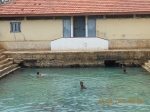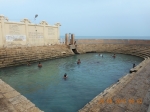Keerimalai Springs
Abstract Category: Science
Course / Degree: Master of Science
Institution / University: Private research, Sri Lanka
Published in: 2015
Keerimalai has good-old natural springs. They are a few tens of metres away from the beach at the northern most stretch of Jaffna district. The springs fill two pools, one for women that is closed to fit the tradition and the other is open and used only by men. The springs serve the pools with slightly salty water throughout the year, with less supply in the dry seasons.
The region is of calcareous ground and of porous limestone. Much water accumulate in such limestone during rains and traverse through the layers. Such layers and deposits are prone to have Caves and Sinkholes. In books they are called also as Karsts and Dolines. As such the origin of pools had to do with sinkholes. When the roofs of sinkholes collapse pools form.
To support the sinkhole-origin of the pools, there is a natural water reservoir at Nilavarai. It is few kilometres land inwards and is also in limestone ground of Jaffna peninsula. This is a very deep natural hole. In modern terms it is a sinkhole formed by dissolution of limestone as the rain water percolates through.
Again, there is another deep well about eight kilometres land inwards in Navaly called Idi-kundu. The origin of which is subject to many speculations. Some say a small asteroid hit the ground and formed the well. Yet it has substantial evidence to have been a sinkhole that collapsed.
At the beginning, many centuries or even millenniums ago, people visited the pools and had fun in them. With time they discovered the health effects of the pools too. As usual words spread, and the pools had become popular. People had begun to visit the pools in numbers. With the crowd, religious establishments found their way in too. Eventually the pools were constructed to bathe in a better way. The region offered excellent atmosphere to meditate and pray.
The Holy Nageswara Temple, beside other temples, was built in the vicinity. Most probably, the region must have had cobras. Naga means cobra and Eeswara is God Siva. Where snakes are hedgehogs thrive too. Hedgehogs eat snakes with pleasure. Hedgehog in Tamil is “Keeri”, and “malai” means hill.
In addition to it, it can be the fourth Eeswara Temple complementing, Thiruketheeswaram, Muneeswaram and Koneswaram. The time of settlements fits well. One Eeswara temple must had been founded and established in the northern most stretch too.
The previously mentioned Nilavarai-Karst and Idi-kundu at Navaly warn that the region must have more underground cavities with water. They can begin with few millimetres in diameter and go having few metres. In this cavities water get stored as the monsoon passes through. The water then travels through pores, cavities and veins and end as springs at Keerimalai. Up until now it has been sufficient to feed the pools throughout the year.
But today, the pool has an unpredictable natural future. The present development of the area brings about much changes in the soil and rocks of the region. Namely, the region becomes increasingly prone to sinkholes or depressions. It is caused by the acidity in the rain, human habitation, animal husbandry, poultry, fertilisers and the depletion of perennial botany. Which means on one-side: there will be rise in sinkholes and underground caves to hold much water in reserve. On the other-side: there will be much surface sealing by constructions. Which means: less water to fill the cavities. And the waters formally held by trees which had gradual percolation into the soil, just run down along the drains into the seas. Thirdly, the rise in porosity will facilitate the flow of water. With it the stored water go rapidly to the pools and rapid emptying of the water-storage in the ground ensue.
The result will be: as sinkholes and pores increase, the amount of water available to reach the pool through veins and pores increases. But this will be only at wet-season. During dry months the pools may run dry rapidly. For, the rise in population and the agro-industries accompanied with the reduction of perennial trees will reduce the amount of water available for the pool in the ground. Under such conditions one cannot say in which direction the breeze will drive the future of the pools. Whatever, it will have good future in different forms, provided early thoughts are made.
The lurking Dangers in Keerimalai region:
The increase in human habitation and removal of perennial trees facilitate much of rain-water to flow towards sea. Only the upper parts of the underground veins and pores will have much water during rains. It will turn the upper portion of underground dynamics from illuviative to eluviative. The amount of cavities and karsts will increase too. It will develop more sinkholes, especially under cemented buildings or tarred surfaces. It may not take centuries. In just few decades one may see them. It may happen that roofs of sinkholes collapse under the houses the way it is happening in many parts of the world. In short: house constructions, water-wells and agro-industries must have a think-over. Especially to cope with acidity and urea of all origins: the main cause for sinkholes. This includes toilets too.
Long Essay Keywords/Search Tags:
Sinkholes
This Long Essay Abstract may be cited as follows:
No user preference. Please use the standard reference methodology.
| Long Essay Images: | |

|
Keerimalai Spring under the stage (click to enlarge) |

|
Pool protected at the sea (click to enlarge) |
Submission Details: Long Essay Abstract submitted by Balasupramaniam Paramahamsa from Sri Lanka on 21-May-2015 10:36.
Abstract has been viewed 3526 times (since 7 Mar 2010).
Balasupramaniam Paramahamsa Contact Details: Email: eecoltd2@gmail.com
Disclaimer
Great care has been taken to ensure that this information is correct, however ThesisAbstracts.com cannot accept responsibility for the contents of this Long Essay abstract titled "Keerimalai Springs". This abstract has been submitted by Balasupramaniam Paramahamsa on 21-May-2015 10:36. You may report a problem using the contact form.
© Copyright 2003 - 2025 of ThesisAbstracts.com and respective owners.